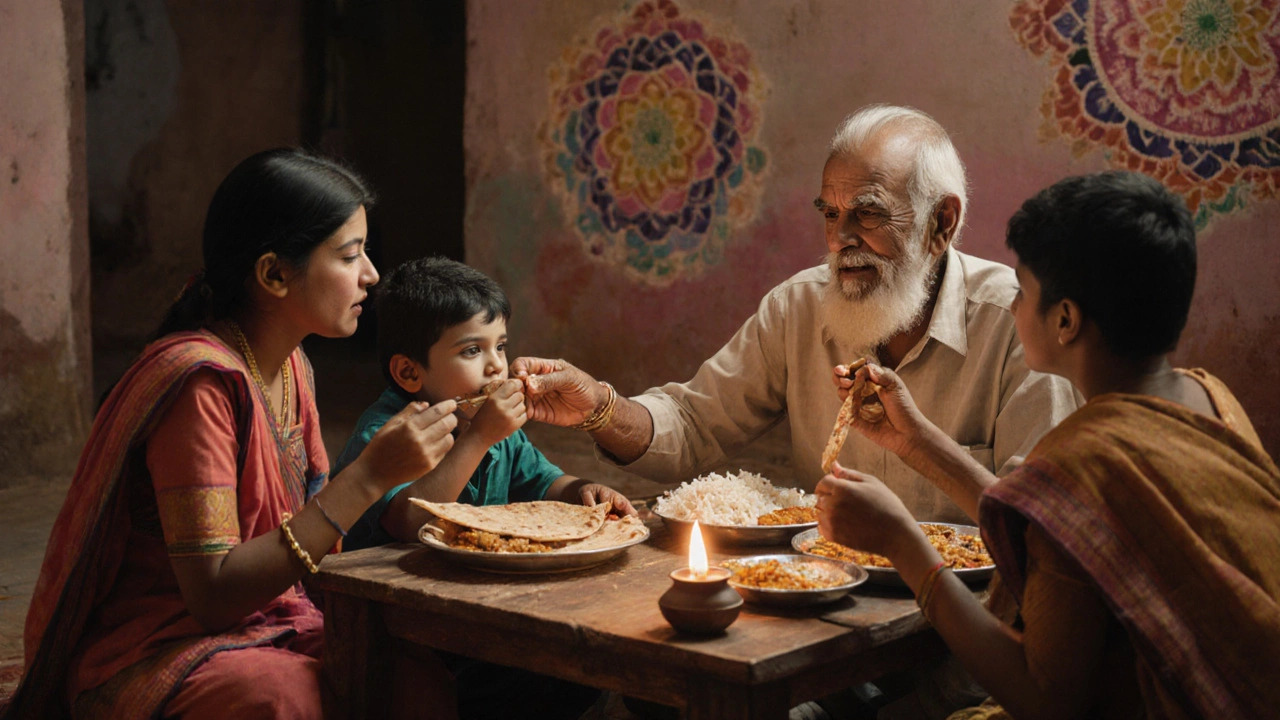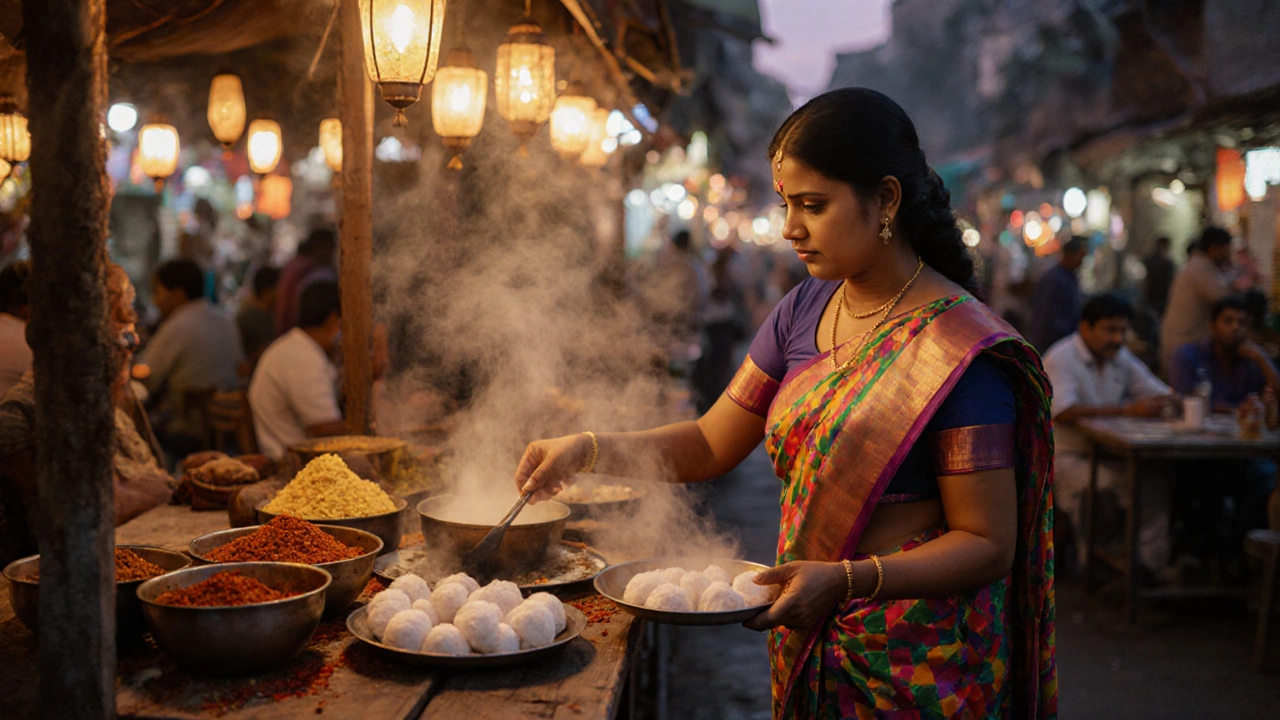21 Nov 2025
- 0 Comments
If you’ve ever eaten at an Indian restaurant abroad and thought, ‘This isn’t what I expected,’ you’re not alone. Many travelers and newcomers to India make the same mistakes-ordering dishes that don’t exist in local homes, eating at the wrong time, or even touching food with the wrong hand. India’s food culture isn’t just about spices and flavors; it’s tied to religion, region, caste, and daily ritual. Eating the wrong thing-or in the wrong way-can be more than awkward. It can be disrespectful.
Don’t assume all Indian food is spicy
One of the biggest myths is that every Indian dish is fiery hot. While chili peppers are common in some regions, many traditional meals are mild or even sweet. In Kerala, coconut-based curries are creamy and gentle. In Bengal, fish cooked with mustard oil has a sharp tang, not heat. In Punjab, butter chicken is rich and smoky, not burning. Asking for ‘less spice’ might get you a bland version of a dish that was never meant to be hot in the first place. Instead, ask: ‘Is this traditionally spicy?’ Then decide.
Avoid beef in most parts of India
Beef is not just unpopular-it’s off-limits for millions. Cows are sacred in Hinduism, which is practiced by over 80% of India’s population. Even in cities where you’ll see beef burgers on tourist menus, local families won’t touch it. In states like Uttar Pradesh, Rajasthan, or Gujarat, serving beef can lead to protests or legal trouble. In the Northeast, where beef is eaten, it’s often goat or buffalo, not cow. If you’re unsure, stick to chicken, lamb, or plant-based options. It’s not about restriction-it’s about respect.
Don’t eat with your left hand
In most Indian homes, meals are eaten with the right hand. The left hand is considered unclean because it’s used for personal hygiene. Even if you’re used to forks and spoons, if you’re invited to eat at someone’s house, follow along. Use your right hand to pick up roti, scoop dal, or roll rice. If you’re left-handed, it’s okay to ask for a spoon, but don’t use your left hand to pass food or touch shared plates. It’s a small thing-but it matters.
Avoid eating in public during religious fasts
India observes dozens of religious fasts each year. During Navratri, Diwali, or Karva Chauth, many people abstain from food or eat only specific items like fruits, nuts, or potato-based meals. If you’re visiting a temple, a family home, or even a small town during these times, eating meat, onions, garlic, or grains in public can draw stares or quiet disapproval. In Varanasi during Shivratri, even eating in restaurants near the ghats is discouraged. It’s not about policing your diet-it’s about not drawing attention to your difference during sacred moments.
Don’t order ‘Indian’ dishes you’ve seen abroad
‘Chicken tikka masala’? That’s a British invention. ‘Naan’ with garlic butter? Rarely found in rural India. ‘Samosa’ filled with cheese? Not traditional. Many dishes marketed as ‘Indian’ overseas are fusion creations made for Western palates. In India, you’ll find regional versions: chicken tikka is grilled, not smothered in sauce. Naan is plain, baked in a tandoor, and eaten with curries. Samosas are filled with spiced potatoes, peas, or lentils. If you want real Indian food, ask locals what they eat at home. Skip the tourist menus and head to neighborhood dhabas or street stalls.
Don’t refuse food when offered
Food is hospitality in India. If someone offers you a bite, a sweet, or even a glass of water, refusing can feel like rejection. It’s not rude to say you’re full-but say it gently. ‘It’s so delicious, I can’t eat another bite’ works better than ‘No, thanks.’ In villages, hosts may insist multiple times. Accepting even a small portion shows you honor their effort. If you have dietary restrictions, explain them politely before the meal. Don’t wait until the food is on the table.

Avoid eating raw or unpeeled fruits from street vendors
While India has amazing street food, hygiene varies. Raw fruits like mangoes, apples, or bananas sold by roadside vendors may be washed in unclean water or handled with dirty hands. Stick to fruits you can peel yourself-bananas, oranges, pomegranates. If you must eat something pre-cut, choose busy stalls with high turnover. Look for vendors who keep their tools clean and wear gloves. Bottled water is a must. Tap water-even in five-star hotels-isn’t safe to drink without boiling.
Don’t assume vegetarian means vegan
Many Indian dishes labeled ‘vegetarian’ include ghee (clarified butter), yogurt, paneer, or milk. Even chapati might be brushed with ghee. If you’re vegan, ask: ‘Is there ghee or dairy in this?’ In South India, coconut milk replaces dairy in curries, making it easier to find vegan options. In the North, most dals are cooked with ghee unless specified otherwise. Don’t assume ‘no meat’ means ‘no animal products.’ Always double-check.
Don’t eat during prayer times in temples
Temples in India have strict rules. You’re not allowed to enter with food or drink in hand. Eating inside temple premises-even snacks-is considered disrespectful. In places like Tirupati or Amritsar, security checks include removing food from bags. Even if you’re hungry, wait until you’re outside. It’s not about hunger-it’s about sacred space. If you’re unsure, ask a temple volunteer or look for signs.
Don’t use your phone at the table
Meals in India are social. Families gather, elders speak first, stories are shared. Using your phone during dinner-checking messages, scrolling, or taking photos-is seen as rude. It’s not just about distraction; it’s about ignoring the people you’re eating with. In cities, younger people might do it quietly, but in homes or villages, it’s frowned upon. Put your phone away. Listen. Taste. Be present.
Don’t eat with your fingers in formal settings
While eating with hands is common in homes and casual spots, formal dinners-especially in business or urban settings-use cutlery. If you’re at a wedding banquet, corporate lunch, or high-end restaurant, follow the lead of others. If spoons and forks are laid out, use them. Don’t feel pressured to eat with your hands if you’re uncomfortable. But if everyone else is, try it. It’s part of the experience.

Don’t order ‘exotic’ dishes just to impress
Some tourists try to impress by asking for ‘monkey brains’ or ‘snake curry’-both myths. India doesn’t serve these. You’ll find goat liver in some tribal areas, or frog legs in parts of Bengal, but they’re not tourist attractions. Ordering strange dishes to seem adventurous can make locals uncomfortable. Stick to regional specialties: dhokla in Gujarat, maas ka salan in Hyderabad, litti chokha in Bihar. These are the real flavors.
Don’t ignore regional differences
India isn’t one country-it’s 28 states with different languages, crops, and customs. In Maharashtra, you’ll find spicy misal pav. In Assam, fish with bamboo shoots. In Kashmir, wazwan feasts with lamb and saffron. In Tamil Nadu, rice is the base, not wheat. If you’re traveling across India, don’t assume the food you had in Delhi will be the same in Chennai. Ask locals what’s special to their area. That’s where the real food lives.
Don’t waste food
India has deep roots in minimizing waste. Even in wealthy homes, leftover roti is saved for the next meal. In villages, every grain is valued. Throwing away food-even a single bite-can be seen as disrespectful. If you can’t finish, ask for a container. Many restaurants now offer free take-home boxes. In rural areas, leftover food might be given to animals or the poor. Don’t treat food like disposable packaging. It’s sacred.
Don’t assume everyone eats the same way
Religion, caste, and region shape what people eat-and what they avoid. Muslims avoid pork. Jains eat only root vegetables harvested after sunset. Sikhs avoid halal meat. Parsis eat beef but not chicken. Dalits in some areas have different food traditions than upper-caste families. These aren’t just dietary choices-they’re identities. You don’t need to understand all of them. But you should respect them. When in doubt, ask: ‘What do you usually eat?’ instead of ‘What can’t you eat?’
What to do instead
Instead of worrying about what not to eat, focus on what to try: fresh masala chai from a street cart, steamed idli with coconut chutney, pani puri bursting with tamarind water, or a simple bowl of khichdi made with lentils and rice. Eat slowly. Watch how others eat. Say thank you. Ask questions. The best Indian food isn’t found in guidebooks-it’s found in quiet moments, shared plates, and open hearts.
Is it okay to eat beef in India if I’m a tourist?
No. Beef is taboo in most parts of India due to the sacred status of cows in Hinduism. Even in cities where it’s available in tourist spots, eating it publicly can offend locals and even trigger protests. Stick to chicken, lamb, goat, or plant-based dishes to avoid cultural conflict.
Can I use a fork and knife in India?
Yes, especially in cities, restaurants, or formal settings. But in homes and rural areas, eating with your right hand is common and appreciated. If you’re unsure, watch others. Using utensils isn’t rude-it’s practical. Just don’t use your left hand to touch food or pass plates.
Are all Indian dishes vegetarian?
No. While many dishes are vegetarian, meat like chicken, lamb, goat, and fish are widely eaten, especially in coastal and northeastern regions. What’s often mistaken for vegetarian is the use of ghee, yogurt, or paneer. Always ask if you’re vegan or avoiding dairy.
Why do Indians eat with their hands?
Eating with hands connects you to the food-its texture, temperature, and aroma. It’s a sensory experience rooted in tradition. The right hand is used because the left is considered unclean. It’s not about hygiene; it’s about mindfulness. Many say food tastes better when eaten this way.
What should I do if I’m offered food I can’t eat?
Politely explain your restriction before the meal if possible. Say something like, ‘I don’t eat dairy’ or ‘I’m allergic to nuts.’ If you’re already at the table, accept a small portion and say, ‘This is so kind, thank you-I’m full.’ Never refuse outright. It’s better to taste a little than to offend.
